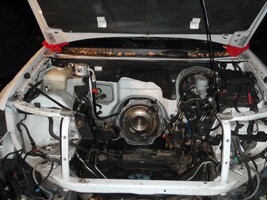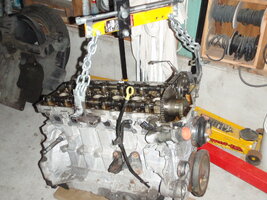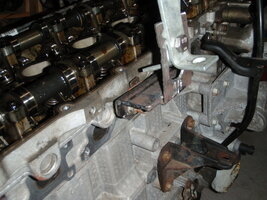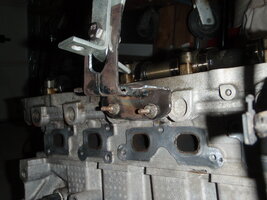My girlfriend's 05 Trailblazer has 220k miles. It overheated last week. Turns out the water pump was leaking like crazy, so I replaced it.
I'm in the process of flushing it - I used a garden hose, then did a few passes with distilled water.
She drove it for 15mins and it didn't overheat. Only saw 200-205. But when it cooled down, I noticed a gunky white hardened paste on the radiator tube (to the upper radiator). I'm pretty sure it is oil that is mixing with the coolant.
I did a oil change and the oil looks fine.
Should I replace the head gasket? How much of a nightmare is this? I've never pulled an engine.
Unfortunately she doesn't have many options. She has 12-15k in credit card debt and just started grad school. So I don't think she should really replace this. But is it worth all the labor and money to go to this?
The trans oil has smelled burnt for a while... not sure how much longer it will last :\
Based on your description / pics, I agree with the others - I don't think that's oil in your coolant.
Usually when a head gasket goes south (due to overheating), you'll see the opposite - coolant getting through passages that were previously closed off, and (depending on the severity) lots of white smoke out the tailpipe.
I'm guessing that the overheating was noticed when the needle was much farther over than "200-205" (this being the post-WP install temp). Get her to point out where the needle was when it overheated. Above 230F for 15min, and I'd almost guarantee the head gasket has been compromised. May not be readily apparent, but it'll need to be replaced at some point. Not 'today', though (more below).
Replacing the head gasket - on this engine, being an OHC, there's more involved. If you had the V8, I'd say 'go for it' - I did a set (in-car) in a Camaro years ago, and knocked both heads out in a day and a half. But it's easier on an OHV engine. You *should* be able to do it in-car, though, if it turns out the head gasket is blown.
The trans fluid should be changed out ASAP. It's a simple job, especially if you have a drain plug in the pan. If you were able to do the WP by yourself, I'd recommend a filter change (you have to drop the pan, but it's pretty straightforward. Torque the pan bolts to 10ft/lb (the spec is in inch-pounds, but I've done the conversion for you) in a crisscross pattern, in at least 2 passes (if you want to tighten in steps (e.g.; 5 ft/lb, then to 10), that's fine - just make sure you do a final (
duplicate) pass at 10 (at least one bolt will yield the second time, so it's important to 'see' 10 across all 13 (?) bolts.
If you have a pan with a 'stepped' section by the exhaust where it crosses over - that's a 'deep pan' (which most 360s have) - make sure you get a filter kit that matches. Oh, and don't worry about the O-ring that is in the pickup tube, unless it shows signs of being damaged, or the filter won't stay seated (very unlikely). The O-ring is very tough to get out, and generally can be reused. Do inspect it, but you can likely leave it as-is.
After you've got your coolant replaced, oil replaced, and trans fluid replaced - drive for 1000mi, take a sample of the oil, and send it in for analysis. If you still have the old oil, send that in, first. That will give you a baseline to compare against, post-fix. If your coolant PPM is still roughly at the same level on the second pass, you'll pretty much know the head gasket is compromised. The company that does the oil analysis will probably give you an idea (especially with two samples) of how bad it will get, how fast. That's when you make your decision on next steps.
If you do the headgasket - You mention sending the head out to be machined (we'll assume you're talking just a cleaning / descaling / 'hot tanking'). If you're going to go that far, you may as well rebuild the head, as you have to remove all the valves, seals, etc., in order to clean it. Personally, I wouldn't do that. Just remove the head, clean it as best you can with your cleaner of choice with the valvetrain intact, and put a good quality headgasket on (FelPro tends to be the trusted brand for most people / daily driver applications.)
If you have the tools / knowledge, measure the deck (block) and head surfaces, to ensure they aren't warped. If they are...well, things get more complicated from there. But it's a good idea to do this, since the motor did overheat, and it's an all-aluminum one, to boot (iron blocks / heads can withstand higher temps before warpage occurs). If either surface is warped, but only slightly, you can try a slightly thicker (or different material) gasket to compensate, if available. Check FelPro's catalogs, etc. For now, let's assume neither surface is warped.
I believe you're going to need a new set of head bolts, as they're likely TTY (torque-to-yield), and those are only supposed to be used once. Some people ignore this - cost & mileage will factor into this decision for you.
On to the other potential leakage source - the radiator.
I think I might just replace this outright, since it has 220K on it - there's a cost to doing this, but if that's where the leakage / intermingling of fluids is occurring, it's a lot cheaper / easier than doing a head gasket.
And finally, we come to cost and "is it worth it, given the mileage?"
- do nothing & roll dice
- fix yourself at some cost
- ditch the truck, figuring that at 230K, it doesn't have much left to give.
Of those three, the last is the most expensive, and it doesn't sound like either of you are comfortable with incurring the expense for a new vehicle. You'll be fixing whatever replacement you get anyway, unless she gets something 'new-ish'. So take that into account.
Choice #2 can be really satisfying, and will score you some major points with the GF

I'd guess that if you fixed it, you'd get her through the 2yrs of grad school with the truck. You may need to oversee the maintenance, down to checking the oil weekly, but it would last 2yrs. Parts are still plentiful, and this site is one of the best on the web to use as a knowledge base. The LL8 is a proven motor - plenty of examples of over 200K, so you're not an outlier.
'Do nothing' is always a choice - but start putting money aside. You've already subconsciously decided not to make this choice anyway, based on your efforts to date.





